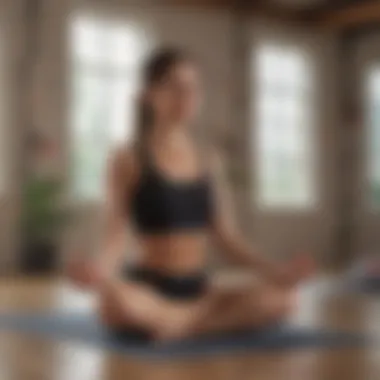Top Free Yoga Apps to Enhance Your Practice in 2020


Intro
In the ever-evolving landscape of personal fitness and wellness, yoga has carved out a significant niche. The accessibility of yoga practice through technology, particularly mobile applications, transformed how individuals approach their practice. The year 2020 showed remarkable growth in the availability and adoption of free yoga apps, making it easier than ever for enthusiasts, both seasoned and novice, to indulge in this ancient practice without the constraints of cost or location.
This article takes a closer look at the notable free yoga apps of 2020. It’s not just about downloading an app and rolling out a mat anymore; it’s about understanding which tools can genuinely enhance your practice. Each app brings its flavor, catering to unique needs, whether you're just beginning your journey or deepening your established practice.
As we progress, we'll explore a range of applications that gained traction in 2020, diving into their distinctive features, user experiences, and the ways they foster a sense of community among practitioners. Our aim is to provide an authentic insight into the best options available, segmenting the apps according to levels of experience and desired outcomes. Whether you're a newcomer looking for guidance or a pro seeking advanced routines, this guide is tailored to help you make informed choices.
Preamble to Yoga and Digital Platforms
In recent years, the realm of yoga has transcended traditional studio settings, increasingly making its way into the digital space. This shift is significant, as it merges ancient practices with modern convenience, making yoga more accessible than ever before. For many, the allure of practicing yoga at home, or on-the-go, speaks volumes about the evolving relationship between wellness and technology. It’s not just about yoga mats and sun salutations anymore; it’s about leveraging apps to enhance our practice, track progress, and connect with other enthusiasts.
The Evolution of Yoga
Historically, yoga began as a spiritual practice in ancient India, and it has morphed into a widely recognized form of physical exercise and mental relaxation in today’s world. As this transformation unfolded, yoga adapted to various cultures, leading to numerous styles and methodologies. What was once exclusive to local practitioners has matured into a global phenomenon, encompassing everything from Hatha to Vinyasa and beyond.
But with this evolution comes the need for a robust platform that can keep pace with practitioners' demands. Digital yoga platforms have risen to the occasion by providing resources that cater to various skill levels and preferences. In essence, these apps reflect the dynamic nature of yoga itself—ever-evolving and adaptable to modern life.
Integration of Technology in Wellness
The fusion of technology in our daily lives has led to a significant shift in how we approach health and wellness. The integration of yoga apps plays a central role in this development. With smartphones and tablets commonplace, the ability to access guided sessions at any time is not just a novelty; it's a lifeline for busy individuals trying to weave mindfulness into their hectic schedules.
Apps like Yoga for Beginners and Daily Yoga provide features that allow users to select classes based on duration, difficulty, and even specific goals such as flexibility or stress relief. This tailored approach not only enhances the user experience but also fosters engagement by allowing practitioners to explore new styles and routines without feeling restricted by location or time.
"The best part about yoga apps is the flexibility they offer. You can find a session that suits your mood right when you need it!"
Criteria for Evaluating Yoga Apps
When navigating the bustling landscape of yoga applications, understanding the bases for evaluation is crucial. Not all apps are created equal, and what works for one practitioner may not resonate with another. The goal here is to dissect the elements that truly matter for users, enabling a focused approach to selecting the right app for their personal journey. The following sections will highlight key considerations like user experience, class variety, instructor qualifications, and community features—each serving as a vital aspect in ensuring a well-rounded practice.
User Experience and Interface Design
User experience isn’t just a fancy term thrown around in tech discussions; it’s the backbone of any app that wishes to keep practitioners engaged. A well-designed interface can make or break the user’s ability to dive into their yoga routine comfortably.
An intuitive layout, easy navigation, and visually appealing design can significantly enhance how users interact with the app. For example, an app structured with clear categories allows users to quickly find their preferred classes or resources, saving precious time in our already busy lives. Moreover, features like voice-guided sessions and video playback play a pivotal role in catering to different learning styles. Ultimately, a seamless user experience can elevate an odd practice into a delightful journey.
Variety of Classes Offered
When it comes to yoga, variety is more than just the spice of life; it’s essential for keeping the practice fresh and adaptable. In 2020, many free yoga apps proved their worth by offering a broad range of classes that cater to all skill levels—beginners, intermediates, and seasoned yogis alike.
Think of it this way: if a user only has access to a handful of classes, they may quickly find themselves lacking motivation. But with options ranging from restorative yoga sessions to fast-paced vinyasa flows, users can experiment and explore diverse practices. Diversity in class offerings can foster a richer, more engaged community, creating opportunities for connection among practitioners.
Instructor Qualifications and Styles


The quality of instruction can dramatically shape a user's experience with a yoga app. Users should consider the qualifications of their instructors—experience, certification, and teaching style all play significant roles. An app that features certified instructors who are adept at various styles of yoga provides reassurance and authenticity to users, ensuring they’re in capable hands.
For example, an instructor specializing in Hatha yoga may not deliver the same energy as a vinyasa expert. Therefore, detailed instructor profiles can help practitioners align with the right teachers for their personal goals and preferences. When users feel confident in their instructor's expertise, they are more likely to engage deeply in their practice.
Community Features
In a world that is increasingly digital, the human connection should not be overlooked. Many yoga apps have recognized this and have integrated community features that allow users to connect with others sharing similar interests. This can range from discussion boards to virtual classes where practitioners can see and interact with one another.
Being part of a community can boost motivation and provide accountability. Users who feel that they are part of something larger tend to stick with their practice longer. Tapping into shared experiences, exchanging tips, and even sharing challenges can enhance the overall yoga experience. The value of community lies in its ability to group individuals together, creating a supportive environment that celebrates progress and encourages growth.
The considerations above are not merely checkboxes; they compose the essence of what makes a yoga app fitting for a practitioner’s needs. By evaluating these elements, users can make informed decisions that will undoubtedly transform their yoga journey into something more enriching and personally rewarding.
Top Free Yoga Apps in
The significance of pinpointing the top free yoga apps in 2020 rests on the intersection of accessibility and wellness. With the increasing necessity for self-care practices, particularly during challenging times, these applications offer users a chance to integrate yoga into their daily routines without financial burden. The beauty of yoga, with its focus on flexibility, mindfulness and physical fitness, can now be carried in one’s pocket. This means no more excuses about missing a class or struggling to find time—just a quick session available at the touch of a button.
When examining the best offerings, it’s vital to consider not just the abundance of classes, but how these apps foster community, guide users through their practice journey, and ensure user-friendly experiences. As we explore this realm, we’ll look closely at what makes these applications stand tall in a crowded market, culminating in profiles of standout apps that have caught the eye of practitioners.
Overview of Key Players
The landscape of free yoga apps is quite diverse. Players like Down Dog, Yoga for Beginners, and Daily Yoga have made significant strides in user engagement and satisfaction. Each app comes equipped with distinct features tailored to different user needs—from comprehensive beginner guidance to advanced routines that challenge even seasoned practitioners.
Down Dog is often heralded for its intuitive interface and customizable features, allowing users to set their preferences for length, level, and even music. On the other hand, Yoga for Beginners has positioned itself as a no-frills go-to for those just starting out, making sure the journey into yoga isn't overwhelming. Daily Yoga strikes a balance between community engagement and diverse offerings, making it a favorite among many users.
Detailed App Profiles
App One: Features and Benefits
Down Dog stands out for its incredibly adaptable structure. The app’s greatest appeal lies in its unique feature of generating customizable yoga sessions that cater to user preferences. It offers an extensive library of practices ranging from five to seventy-five minutes, catering to all experience levels. This flexibility allows users to tailor their yoga experience according to time constraints or specific skill levels.
One key characteristic that attracts users is the incorporation of voice instruction combined with soothing background music. It creates a cozy atmosphere that enhances practice. The convenience of being able to select specific focuses such as strength, stretch, or relaxation is a notable advantage. However, a minor downside could be that some users might find the sheer volume of options daunting.
App Two: Features and Benefits
Yoga for Beginners claims its popularity through simplicity. Designed specifically for those new to yoga, the app provides straightforward routines with clear instructions. This feature helps ease users into their bodily movements without the intimidation that sometimes accompanies starting a new fitness journey. Each pose is explained with a helpful video guide which demystifies unfamiliar techniques.
The notable highlight is its emphasis on foundational techniques, ensuring that users build strong habits right from the start. This makes it an excellent choice for women of all ages looking to cultivate a practice without feeling lost. However, advanced practitioners might find the limited offerings stifling after a while.
App Three: Features and Benefits
Daily Yoga takes a different route by incorporating a strong community aspect alongside its offerings. The app not only provides a myriad of sessions but also features classes led by well-known instructors, adding credibility and expertise to its teaching style. Users often rave about the vibrant community that engages in shared challenges.
With features like guided meditations and a tracker to log progress, the holistic approach caters to many facets of personal wellness. The downside, perhaps, is that the wealth of options might overwhelm newcomers who are unsure where to begin. The social features, while enriching, may also require more interaction than some users feel comfortable with.


A sound yoga app should not just cater to your skill level, but encourage you to explore and grow beyond it.
In the ever-evolving landscape of health and wellness, finding the right tools like these free yoga apps can enhance one’s practice significantly, encouraging a deeper connection not only to the yoga mat but to oneself.
User Experiences and Reviews
Understanding users’ experiences and reviews is essential when evaluating yoga apps. Each individual’s journey through yoga can differ widely due to personal goals, body types, and even emotional connections to the practice. Thus, these personal accounts offer a glimpse into how specific apps can resonate with various users, guiding newcomers to make informed choices.
User reviews serve as a reflection of the functionality and engagement that apps provide. When practitioners share their insights, they highlight which features helped them during their practice and discuss any shortcomings they encountered. This communal sharing paints a broader picture that can be invaluable for potential users, helping them to gauge the effectiveness of the apps before diving in. Furthermore, considering user feedback allows developers to identify common issues and improve their products, which, in turn, benefits the entire yoga community.
Testimonials from Practitioners
Practitioners' testimonials provide real-life stories; they embody the various dimensions of yoga practice through apps. These accounts can cover a wide breadth of experiences. For instance, one user might express how the Calm app helped her overcome anxiety through guided sessions that promote mindfulness, while another may have felt empowered by the structure of the insights offered by the Yoga for Beginners app.
- A thoughtful testimonial might sound like this: "I never thought yoga could alleviate my stress levels, but Yoga Studio has changed that for me. The classes fit into my busy schedule, allowing me to practice while balancing work and family responsibilities."
- Or perhaps: "The community features in Down Dog have helped me connect with others who are on similar journeys, making my practice feel less isolated."
These testimonials act as catalysts for stirring interest and empathy. They reveal the personal transformations that practitioners undergo, establishing a connection that is often missing from mere descriptions or sales pitches of the app’s features.
Comparative Analysis of User Ratings
User ratings serve as an evaluative measure that can quickly inform potential users about an app's overall reception. While every individual may have unique preferences, examining the broader ratings can assist in identifying patterns or trends that surface among users.
High-star ratings often signify a well-developed app, suggesting that it meets user expectations concerning usability, content, and engagement. Conversely, low ratings can serve as red flags indicating persistent issues that the developers may need to address.
Overall, here’s why reviews and ratings matter:
- They show what features users love.
- They highlight common problems.
- They can influence decision-making when choosing an app.
When analyzing user ratings, factors such as the number of reviews and the diversity of user backgrounds play a crucial role. An app may have an average of four stars, but if it has a high volume of ratings from diverse demographics, that indicates a consistent quality across different users. Moreover, looking into the specifics – such as whether an app excels in beginner classes versus advanced sessions – can inform a more nuanced understanding of its capabilities.
Challenges of Using Yoga Apps
In the realm of digital wellness, free yoga apps have made a considerable impact, filling the gap for many seeking balance and flexibility in their lives. However, they don’t come without hurdles. Understanding these challenges is crucial as they influence the overall effectiveness and satisfaction users experience. This section takes a closer look at two primary hurdles: adapting to individual needs and maintaining motivation.
Adapting to Individual Needs
Yoga is a deeply personal journey, often shaped by physical capabilities, mental states, and individual goals. Yet, many free yoga apps offer a one-size-fits-all approach, which can be problematic. While they provide a wealth of content, not every app tailors its sequences and poses to accommodate various experience levels.
For example, beginner yogis might find themselves lost in technical terms without proper guidance, potentially leading to injuries. On the other hand, seasoned practitioners may feel underwhelmed by basic sessions that don’t challenge them. This disconnect underscores the importance of personalized programming within any yoga app.
Key considerations include:
- User Profiles: Many apps should consider integrating features for users to input individual preferences and experiences. This involves initial questionnaires about their yoga history, physical limitations, and goals. The app can then adapt its offerings accordingly.
- Customization Options: Rather than following a rigid program, users should have the opportunity to mix and match various classes based on mood or specific needs. This flexibility can greatly enhance the yoga experience and keep users engaged over time.


"Yoga is not about touching your toes, it’s about what you learn on the way down."
— Jigar Gor
Maintaining Motivation
Another formidable challenge is keeping motivation levels high over time. Practicing consistently is critical to mastering yoga, but the temptation to abandon the digital mat is all too real. Factors contributing to this decline often include lack of accountability, absence of social interaction, and burnout from repetitive routines.
Consider the implications of motivation within yoga practice:
- Accountability Mechanisms: Users may benefit from features prompting them to stick to their schedules. Reminders, badges for achievements, or a virtual coach could play a vital role in cultivating a habit.
- Community Features: Building an online community could serve as a motivational lifeline, where users can share experiences and progress. Engaging in forums or social media groups tied to the app can foster a sense of belonging.
- Diverse Content: Stagnation often leads to disengagement. Apps that regularly update their libraries with diverse styles—like Ashtanga, Hatha, or Restorative yoga—can reinvigorate interest and provide fresh insights into practice.
Addressing these two challenges requires a concerted effort from app developers to create more user-centric designs. By enhancing how yoga apps adapt to the specific needs of practitioners and reinforcing motivation through community engagement, users can enjoy fulfilling digital experiences that elevate their practice.
Future Trends in Yoga and Technology
Exploring the intersection of yoga and technology reveals a landscape ripe with innovation, shaping practices that cater to modern needs. This section dives deep into emerging trends that not only enhance how enthusiasts engage with yoga, but also provide meaningful insights into the evolving wellness journey. Understanding these trends is crucial for yoga practitioners and app developers alike. With technology increasingly woven into our daily lives, the potential for creating personalized yoga experiences has never been greater.
Emerging Technologies in Yoga Practice
As we progress into an era saturated with digital tools, yoga practitioners are reaping the benefits of sophisticated innovations. One of the standout advancements has been the integration of virtual reality (VR) and augmented reality (AR) into yoga apps. Imagine stepping into a serene studio or practicing at a majestic mountain location, all from the comfort of your living room. These immersive experiences enable users to engage with their practice on a much deeper level.
- Artificial Intelligence: AI is not just a buzzword; it's changing how yoga practices are tailored. Intelligent algorithms can analyze your performance, offering personalized suggestions to correct your alignment or adjust your flow.
- Wearable Technology: Devices like smartwatches and fitness trackers monitor heart rate and stress levels during practice. This data-driven approach empowers practitioners to fine-tune their sessions based on real-time feedback.
- Online Classes: The shift to livestream yoga sessions has popularized access to well-known instructors across the globe. No longer restricted by geographical boundaries, participants can now learn from experts just a click away.
Each of these technologies fosters a more interactive and adaptable practice. Users are no longer passive observers—they become active participants, allowing them to engage with yoga in ways that resonate with their unique lifestyles.
The Role of Community in Virtual Environments
Alongside technological advancements, the strength of community remains vital in sustaining a fulfilling yoga practice. While the ability to practice alone has its merits, engaging with others can significantly amplify the experience. Virtual environments have created unique platforms where community thrives, fostering connection among practitioners from diverse backgrounds.
To illustrate this, consider the following aspects:
- Shared Experiences: Apps that encourage community discussions and forums allow users to share their experiences, similar to the camaraderie found in a traditional studio. Participants can celebrate milestones or exchange tips, creating a sense of belonging.
- Group Challenges: Many apps offer virtual challenges that prompt users to achieve particular goals together, whether it's committing to daily practice or mastering a specific pose. These challenges foster a sense of accountability.
- Live Interaction: Live classes provide an avenue for real-time interaction with instructors and participants, making the practice feel more personal. It’s like a class where everyone knows your name—except it’s conducted through a screen.
Ending
As we wrap up this exploration of free yoga apps available in 2020, it’s crucial to reflect on what has been discussed. This article has traversed the diverse landscape of digital yoga, highlighting how these applications can be effective tools for enhancing our practice, regardless of experience level.
Summarizing Key Insights
To summarize, the rise of yoga apps has democratized access to wellness and mindfulness activities. Users can engage with various programs tailored to their unique needs, whether they are just stepping onto the mat for the first time or are seasoned practitioners perfecting their poses. Here are some key insights from our discussion:
- User-Friendly Interfaces: Many of the reviewed apps made significant strides in creating seamless user experiences. This focus helps users feel confident navigating through sessions without technological hitches.
- Diverse Class Offerings: Yoga apps are no longer limited to the basics. Several platforms now boast an extensive library of classes ranging from gentle restoratives to intense power flows, catering to all tastes and preferences.
- Expertise of Instructors: The qualifications and styles of instructors have a big impact on user satisfaction. Many apps feature seasoned yoga teachers who bring depth of knowledge, enhancing the quality of the practice.
- Community Engagement: A strong sense of community can motivate users, fostering connections that might be absent when practicing alone. Features allowing interaction can deepen the sense of belonging.
"Yoga is not just about poses; it's about community and growth."
The Future of Yoga Apps
Looking ahead, the future of yoga apps seems promising. Emerging technologies such as augmented reality and virtual reality could revolutionize how users interact with their practice. Imagine stepping into your living room only to find yourself in a serene studio overlooking a beach, guided by your favorite instructor as if they were right there with you.
Moreover, the integration of Artificial Intelligence can provide personalized experiences. Apps can analyze user performance and offer real-time feedback, adjusting classes to better cater to individual progress. Maintaining community through features like live classes or interactive platforms will remain essential. The ability to share experiences, challenges, and achievements can inspire those practicing at home to stick with their routines.
In summary, these considerations signal that yoga apps will likely evolve into an even more integral part of our wellness journey, providing not just physical exercise but a deeper connection to ourselves and others. Advocating the need for self-care through technology is more relevant than ever, highlighting the role these tools can play in creating a harmonious balance in our daily lives.



